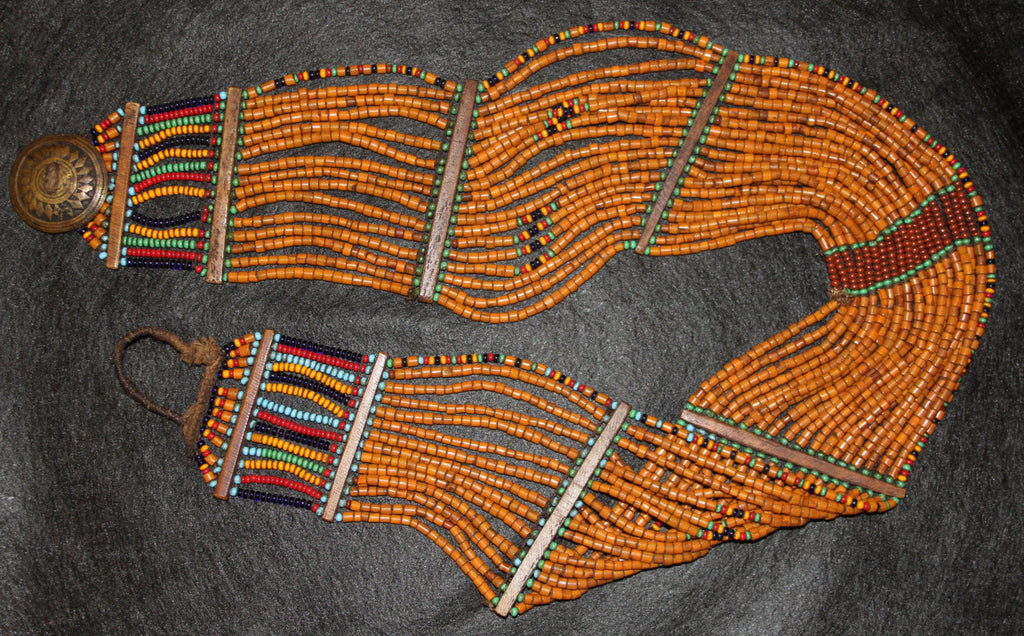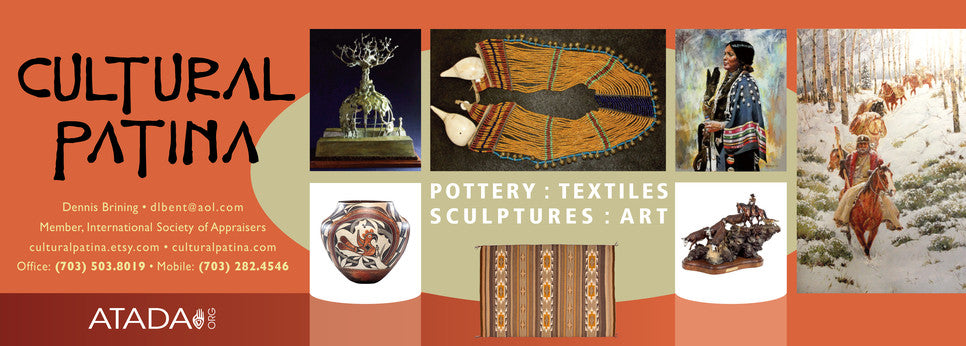
Naga Beads : Vintage Konyak Naga Beaded Belt/Sash from North East India #542
$ 1,400.00
Naga Beads
Vintage Konyak Naga Beaded Belt
542. Konyak Naga Beaded Belt/Sash from North East India. Approximately 36" long and 4.5" at its widest point. Multi colored glass beads separated by bone spacers. The clasp has a large brass button. The piece is in overall good condition for its age which could be early to mid 1900"s. This piece of attire was once the only item worn by the girls of the lower Konyak when the British first made contact. Provenance: A couple in London, England who received this piece as a wedding gift from highly placed members of the Brides family in Nagaland where they were married many years ago.
The Konyak are a Naga people, and are recognised among other Naga by their tattoos, which they have all over their face and hands; facial tattoos were earned for taking an enemy's head. They are called the land of Angh's. They have the largest population among the Nagas.
The Konyaks can be found in Myanmar, in the Tirap and Changlang districts of Arunachal, and in the Mon district of Nagaland, India. They are known in Arunachal as Wancho Konyak.
The Konyak language belongs to the Northern Naga subbranch of the Sal subfamily of Sino-Tibetan.
Known as head hunters of North East India. In the recent past, they were known as war loving and often attacked nearby villages of other tribes taking the heads of opposing warriors as trophies to hang in the Morong (a communal house). The number of heads indicated the power of a warrior and the tribe and becomes a collective totem. With the exception of these behaviors, the tribal members maintain a much disciplined community life with strict duties and responsibilities for every individual.
Nagaland has a rich diversity of ethnic groups, languages and religions. More than 80% of the population lives in small, isolated villages and practice their own rituals and traditions that have been existing since centuries. The Nagas are said to belong to the Indo-Mongoloid stock, a race whose presence was first noted ten centuries before Christ, at the time of the compilation of the Vedas. The Nagas are mostly Christians.
Naga Features: The Nagas are usually medium sized. The nose is flat, eyes curved, complexion fair, and hair straight. Men are muscular and women are usually short. One unique feature of the Nagas is that they wear conical red headgear decorated with wild boar canine teeth and white black Hornbill feathers, the spear with the shaft decorated with red black hairs and the unique dao with broad blade and long handle. Both men and women wear traditional Naga jewellery. Naga shawls are very famous among the tribes. Tattooing is customary among the tribes.
Nagaland Culture
The tribes of Nagaland are unique in their culture and traditions. The tribes are excellent and skilled craftsmen. Naga tribes are known for being hard working and laborious. They are known for making exquisite bamboo and cane products, weaving and wood carving. The Nagas are expert in basketry, weaving, woodcarving, pottery and metal work. Agriculture is the main occupation of the people. Rice, millet and Taro potato are grown by the people.
The tribes of Nagaland are very fond of dance and music. Music forms an essential parts of their lives. There are different traditional dances and music of the different tribes. The music of is characterized by folk songs and music accentuated by traditional instruments.
People of Nagaland are also famous for celebrating numerous seasonal fairs and festivals. All the tribes celebrate their own distinct festivals with dance and music. The most important festivals celebrated by the tribes include Sekrenyi, Moatsu Mong, Suhkruhnye, Bushu, Yemshe, and Metumniu among others.
The food of the Naga tribe consist of rice, millet, vegetables, fish, meat, Naga chilly and chutney.
Nagaland Village System: The tribes live mainly in villages. For the Nagas family is the most important institution. Women are treated equally with men. Nagas are traditionally and tribally organized with a strong warrior tradition. Head hunting is an important aspect of the people. Most of the houses of the Nagas have skull displaying their warrior qualities.
Different Tribes of Nagaland: Nagaland is home to some 16 different kinds of tribes with distinct and fascinating cultures. Each of the Naga tribe is divided into as many as twenty clans. The Nagas speak 60 different dialects. The prominent tribes are Angami, Ao, Chakhesang, Chang, Khiamniungan, Konyak, Lotha, Pochury, Phom, Poumai, Rongmei Naga, Rengma, Sangtam, Sema, Mao and Zeliang among many others. The languages of the Nagas may vary from Angami-Pochury, Ao, Kukish, Sal, Tangkhul and Zeme branches of Tibeto Burman.
Some important tribes are:
Angami Naga: The Angami Nagas are one of the major tribes of Nagaland. The Angamis mainly celebrate the Sekrenyi festival. They are basically hill people and depend on agriculture for their mode of livelihood. 98 % of the Angamis are Christians.
Ao Naga: Ao Nagas are another major tribes in Nagaland. They reside mainly in Tsula to Tsurang in Mokokchung district. The Ao Nagas are known for the celebration of different harvest festivals. The Aos are primarily Christians.
Chang: Changs are one of the recognized Scheduled Tribes in India. The traditional territory of the Chang lies in the Central Tuensang district. About 99 % of the Changs are Christians. They speak the Chang language and the Chang people are very fond of music and dance. They celebrate Christmas, Naknyu Lem, Poang Lem, Jeinyu Leam and so many other festivals with fanfare and gaiety.
Konyak: Konyak have the largest populations among the Nagas. They are found in the Mon district of Nagaland. They are famous for their tattoos all over their faces and hands.
Lotha: Lotha is also a major Naga tribe and reside in the Wokha district. They are popular for traditional dance and folk songs.
Sumi: Sumi Nagas are one of the major Naga tribes. They mainly inhabit in the Zunheboto district. 99 % of the Sumis are Christians. Tuluni and Ahuna are the most important festivals of the Sumis.
Yimchunger: Yimchunger is a minor Naga group. Metmneo festival is celebrated by the Yimchunge people.
Khiamniungan: Khiamniungan is comparatively a minor Naga group. They mainly reside in the Tuensang district in Nagaland. Miu festival and Tsokum festival are the most important festivals celebrated by this tribal group. (Source: India on line)
Tangkhul: Tangkhul is a Naga tribe living in the Indo-Burma border area occupying the Ukhrul district in Manipur, India and the Somra Tangkhul hills (Somra tract) in Upper Burma. Despite this international border, many Tangkhul have continued to regard themselves as "one nation".[1]
Further reading
Stirn, Aglaja & Peter van Ham. The Hidden world of the Naga: Living Traditions in Northeast India. London: Prestel.
Oppitz, Michael, Thomas Kaiser, Alban von Stockhausen & Marion Wettstein. 2008. Naga Identities: Changing Local Cultures in the Northeast of India. Gent: Snoeck Publishers.
Kunz, Richard & Vibha Joshi. 2008. Naga A Forgotten Mountain Region Rediscovered. Basel: Merian.
Alban von Stockhausen: Imag (in) ing the Nagas: The Pictorial Ethnography of Hans-Eberhard Kauffmann and Christoph von FÌ_rer-Haimendorf. Arnoldsche, Stuttgart 2014, ISBN 978-3-89790-412-5. (Source: Times of India)




